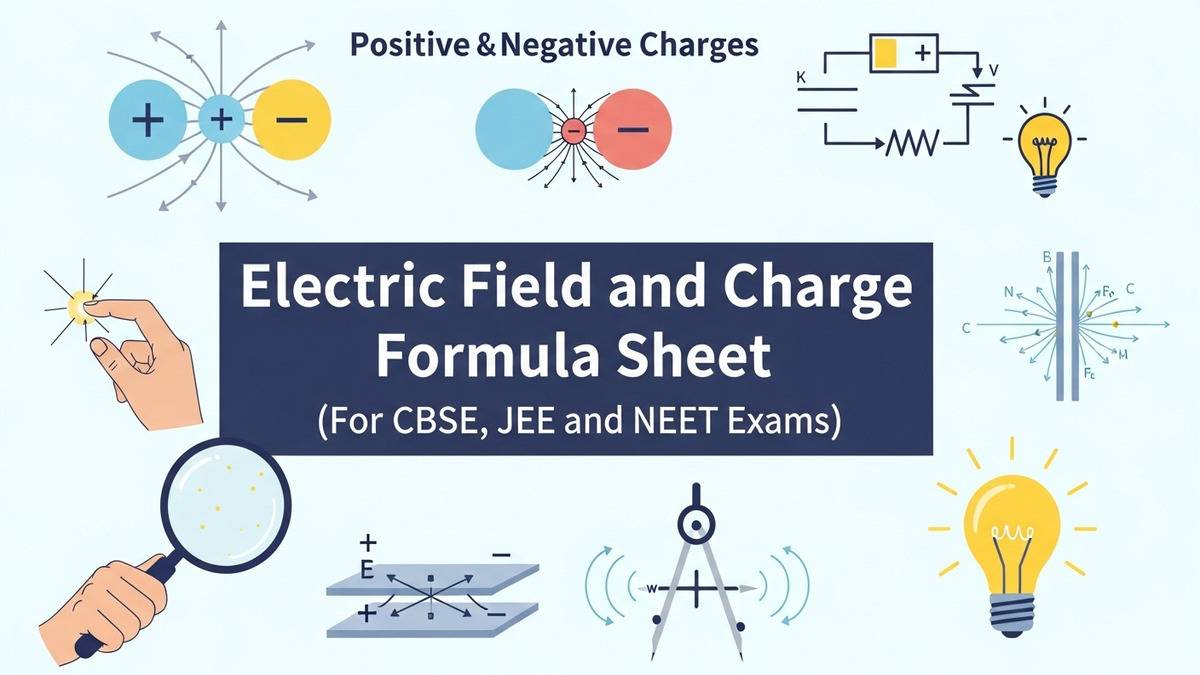This article covers all Class 12 Electric Field and Charges Formulas. You can practice problems related to the electric field, field equilibrium, charge in motion, Coulomb's force, electric dipole, and other topics using these formulas.
Students need a concise and useful formula revision sheet to learn and practice numerical problems. We provide the Electric Field and Charge Formulas below to fulfill all your needs. You can revise and practice numerical problems for various exams such as CBSE, JEE Mains, and others using given formulas.
We provide complete study material for Class 12 physics that includes NCERT Notes, important questions and NCERT Solutions. The related study material to give you a comprehensive preparation experience is also available in table below. You can read the Class 12 Physics Electrostatics Formula Sheet for Chapter 1 below.
- Electric Charge Formulas
- Formulas For Electrostatic Force
- Electric Field Intensity Formulas
- Charge Density Formulas
- Electric Flux
- Gauss’s Law and Its Applications
- Electric Dipole
Electric Charge Formulas
- Net charge when there is a gain or loss of n electrons:
- Net charge passing through a circuit in time t sec:
- Net charge in a system of n individual charges:
Formulas For Electrostatic Force
- Coulomb Force between two charges separated by distance (r):
- Vector Form of Coulomb's Law:
- Net force for a system of multiple charges:
Electric Field Intensity Formulas
- Electric field due to a point charge, which exerts an electrostatic force (F) on a test charge (qo)
- Electric field due to a point charge (q) at a distance (r):
- Electric field due to a ring of charge of radius (R) and total charge (Q) at a distance x from the centre on the axial line.
Charge Density Formulas
When a charge is distributed over any geometrical shape.
- Line charge density:
- Surface charge density:
- Volume charge density:
Electric Flux
It is the amount of net electric field passing through a specific region of space.
| Related Study Material for Class 12 Physics Chapter 1 |
|---|
| Electric Field and Electric NCERT Notes |
| Class 12 Physics Chapter 1 Quick Revision Notes |
| Chapter 1 Electric Field and Charge NCERT Solutions |
| Class 12 Electric Field and Charge NCERT Exemplar Solutions |
Gauss’s Law and Its Applications
Gauss's law states," The total electric flux passing through an enclosed Gaussian area (imaginary) is 1/ε₀ of the enclosed charge within the surface."
Application of Gauss's Law
We can use Gauss's law to find the field intensity for symmetrical charge distributions.
-
Electric field due to an infinite line charge: ( λ is linear charge density)
Electric field Intensity due to an infinite plane sheet of charge: ( σ is surface charge density)
Electric field Intensity due to a uniformly charged conducting sphere
- Outside:
- On Surface:
- Inside
Electric Field due to a non-conducting charged sphere
- Outside of the sphere:
- On the surface:
- Inside the sphere:
Electric Dipole
A system of two equal and opposite charges (q) separated by a small distance (d).
Dipole moment:
Electric Field Due to Electric Dipole
- On Axial Line:
- On the Equatorial Line:
Torque due to an electric dipole when placed in an electric field of intensity (E):
Potential Energy due to an electric dipole: (Negative of work done by dipole in electric field E)
| Complete Class 12 Physics Study Material |
|---|
| Class 12 Physics NCERT Notes |
| Class 12 Physics NCERT Solutions |

